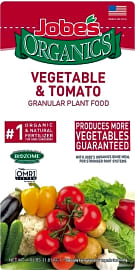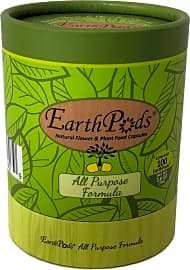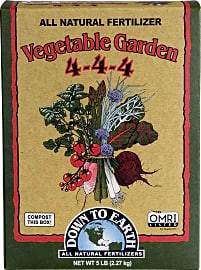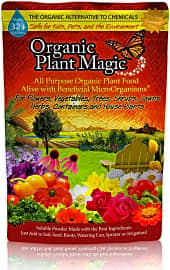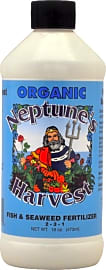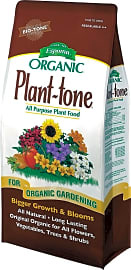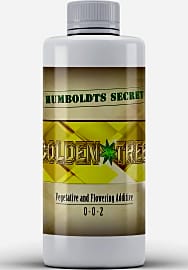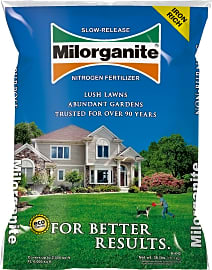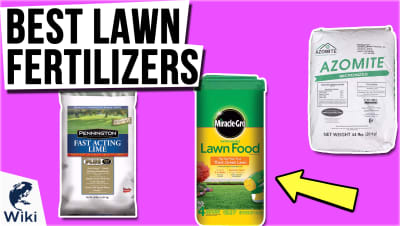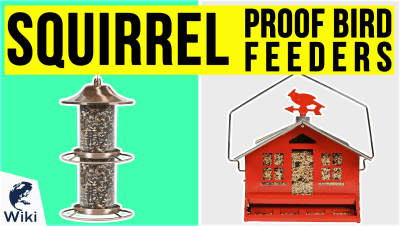The 10 Best Organic Fertilizers

This wiki has been updated 43 times since it was first published in May of 2016. If you are looking forward to enjoying all the fruits and vegetables you are growing in your garden, make sure you don't harm them -- or your family -- by adding toxic chemicals to the soil. These organic fertilizers will enable you to produce more healthy, tasty, and nutritious foods than you can find at your local supermarket, and most are safe to use around kids and pets. When users buy our independently chosen editorial selections, we may earn commissions to help fund the Wiki.
Editor's Notes
December 17, 2020:
Organic fertilizers continue to climb in popularity, both with experienced gardeners and landscapers and novice indoor plant owners. We maintained the diversity this list had to ensure there was something for every need and made a few tweaks to do so.
To start, we replaced Espoma Tomato-Tone with Espoma Plant-Tone, as it's just as effective but less specialized, so more people can use it to achieve solid results. We said goodbye to Fox Farm Big Bloom, another option that's still useful, to bring on the ever-popular and extremely budget-friendly Jobe’s Organics. Like with the EarthPods Premium, Jobe's offers formulas for nearly every kind of plant one might cultivate. That includes succulents and herbs.
Also joining the ranks today is Down to Earth 4-4-4, which we added in place of Down To Earth All-Purpose for those who are tending vegetable gardens. It still has some of the same prized ingredients, like fishbone and feather meal, kelp, and alfalfa. Finally, we noticed there was nothing here particularly geared toward lawns and grass, and so brought on Milorganite 0636 for those trying to keep their front and backyards looking verdant. This slow-release formula won't burn your grass or kill other plants and works over weeks with 4% non-staining iron for green without growth. That means less mowing and water usage.
We have liquid, granular, and stake-style fertilizers here today, with many granular options also acting as a good compost starter for your composting bin when mixed with water. They can often be dispensed into your soil in that form, too.
May 23, 2019:
Whether you're growing delicious garden vegetables to feed your family, tending to shrubs, trees, and other landscaping, or simply want to keep toxins out of your indoor potted plants and away from pets and children, there is an organic fertilizer for every need. Our diverse list features options to suit those needs, with the inclusion of everything from bat guano and chicken manure to hydrolyzed fish, seaweed, and greensand. Naturally, we prioritized products by effectiveness and sustainability as well as price and composition (liquid or granular) and ease of application.
While we still stand by our previous Shin Nong Pro as a solid selection, we felt that a more effective replacement was needed. We chose Down To Earth All-Purpose, another gentle, OMRI-listed formula that's jam-packed with proven, popular ingredients.
The easiest of our selections to apply are the EarthPods Premium capsules, which simply need to be pushed into soil near the root. For flowers, consider Fox Farm Big Bloom and for vegetables, Espoma Tomato-Tone. If you have plants that are faltering and need a jump start, Humboldts Secret will serve you well. Bear in mind, though, that it can be tricky to administer if you're not a seasoned gardener.
We elevated Unco Industries Wiggle Worm due to its fast-acting, effective formula, attractive price, and versatility. It's odor-free, and it only takes a little to see positive results.
Special Honors
Urban Organic Gardener The Seed Club Urban Organic Gardener is a website that offers DIY help, pest deterrent tips, informative articles, and a monthly subscription box called The Seed Club. Each month, recipients receive a special collection of heirloom seeds and gardening supplies, personally curated based on questionnaire results. It includes everything needed to plant in-season offerings that are appropriate for your garden type and location. urbanorganicgardener.cratejoy.com
Garden Manager Garden Manager is a new app that helps green thumbs get the most out of an edible garden. It designs a custom program for your personal space and takes you from planting to harvest by leading you through a series of questions. By learning your favorite foods, garden specifications, and local weather, it helps your plants thrive and offers secret tricks and handy reminders. There are three levels of subscription services. gardenmanager.com
Selecting The Right Organic Fertilizer
Pellet fertilizer is slower to break down than powders, thus is great for use around established shrubs, trees, and bushes that will benefit from extended feedings.
Fertilizers are an invaluable aid in raising and maintaining plant life as they serve to replace the nutrients that are depleted from soil as a plant grows. With the right type and ratio of fertilizer, planted fields, beds, and pots need not be left fallow and need little fresh soil year after year, leading to greater efficiency and ease of horticultural management that farmers and gardeners from eras past could scarcely have imagined.
Whether you are concerned about your health and the wellbeing of other people who come onto your property and/or eat foods you raise, if you are dedicated to protecting the environment and eco-system, or if you just don't trust the chemicals used by major agribusinesses, using organic fertilizer is a great way to help your plant's robust growth while minimizing exposure to potentially harmful substances.
More often than not, selecting the right organic fertilizer for your needs is as easy as considering what types of plants you will be assisting and then doing a bit of research and reading. Most fertilizer blends are created with specific types of plant in mind, so whether you are hoping to grow robust, productive tomatoes or if you want to restore your lawn to its healthy, verdant luster, with some looking, you can surely find the right fertilizer formula for your needs.
What might require a bit more thought is not so much determining the right fertilizer formula, but the best physical type of fertilizer to use. Organic fertilizers come in pellets, powders, stakes, and liquid form. And not all types of fertilizer mediums are equally appropriate for varied applications.
If you are trying to grow a full bed of flowers (such as pansies or moss roses, for example), then turning a handful of powdered fertilizer into each cubic foot of soil is a good approach. For helping citrus trees create tasty, robust fruits, driving stakes of fertilizer into the ground a few feet away from their trunks is the way to go. Pellet fertilizer is slower to break down than powders, thus is great for use around established shrubs, trees, and bushes that will benefit from extended feedings. And finally liquid based fertilizers are great for smaller beds, potted plants, or even for mixing into the water of hydroponic systems.
Perfect Soil Preparations
Any gardener or landscape professional with a bit of knowledge and experience knows that too much of a "good thing" is actually a bad thing; that is to say, too much fertilizer can be every bit as detrimental to a plant than too little. In fact, it can worse: in high enough concentrations, fertilizers can effectively "burn" a plant, potentially even killing it.
Fertilizer burn typically occurs when an oversupply of nitrogen salts draws too much moisture out of a plant, leaving its leaves (and sometimes its stalk and even the roots) dried and damaged. Fertilizer burn can affect everything from the grass of a lawn to edible food crop plants to flowers and beyond.
To make compost, be sure to remember the basic guideline of a twenty to one ratio of carbon to nitrogen.
The best way to avoid damaging a plant by the use of too much fertilizer also happens to be the best way to prepare soil for new plantings, as well: pre-mixing soil and fertilizers creates a fecund material ready to help flora grown and thrive. Whether you are preparing a bed for a new year of tomato or pepper plants or you're turning new earth into the ground around a well established citrus tree or row of hedges, choosing the right fertilizer and then mixing it with healthy soil -- and, ideally, some homemade compost as well -- will do wonders for your vegetation.
If you make your own compost, you are well on your way to enjoying wonderfully healthy plants. Mixing a few scoops of compost into each wheelbarrow full of soil (whether fresh soil or that you scoop up from your own land) and then adding a handful of fertilizer can create a nutrient-rich material that may well see your plants needing nothing but water and sunshine for an entire growing season. To make compost, be sure to remember the basic guideline of a twenty to one ratio of carbon to nitrogen. That is to say, for every twenty parts of a compost blend made of substances like straw, pine needles, or sawdust to one part nitrogen rich materials like food scraps, grass clippings, and coffee grounds.
Differences Between Organic And Inorganic Fertilizer
As far as the plant is concerned, there is little difference between organic and inorganic fertilizers. Both substances deliver compounds the plants need for ideal growth and development, the only difference being the source of these compounds. The real difference between the two substances is that an inorganic fertilizer helps plants without doing much (if anything) to renew the health of the soil itself. Organic fertilizers can both help a plant grow and can help replenish the nutrients and balance of the surrounding earth beyond the roots.
As far as the plant is concerned, there is little difference between organic and inorganic fertilizers.
In an inorganic fertilizer, the nutrients that will feed the plant are usually derived from petroleum products. Petroleum can be refined into a potent source of the nitrogen a plant needs, but it is a non-renewable resource that can damage the earth during extraction and, ironically, damage it again when put back in the ground as a fertilizer. That's because while nitrogen (and other compounds, like phosphorous) can help plants grow, they also kill off many of the minute organisms that live in soil and which are usually responsible for helping maintain the healthy, natural balance of fertile land.
So fields, beds, or gardens treated with inorganic fertilizer may see a year or two (or even more) of healthy plant growth, it's likely that each year will require more and more fertilizer to yield the same results, thereby further damaging the soil. Eventually, earth exposed to too much inorganic fertilizer simply must be left barren for years or more, or else must be replaced.
Thus while a plant may grow just as well whether it receives organic or inorganic fertilizer, the gardener or farmer concerned about the greater good will always choose the naturally derived approach.


